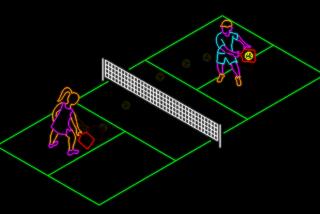Pinball Hall of Fame in Las Vegas tilts toward nostalgia
Reporting from Las Vegas â Drop a quarter in a Las Vegas machine: lights blink, bells ring and odds are your money is headed to a casino bank account. But experiencing those same effects while your funds are funneled to charity? Thatâs definitely outside the Sin City norm.
This is what happens at a little known Vegas pleasure palace, the Pinball Hall of Fame, a five-minute drive east of the Strip. The 10,000-foot cinder-block building is thought to house the largest collection of historic pinball machines operating in America. At any given time, there are about 200 in the hall, all primed for play.
The Pinball Hall of Fame is owned by a pinball acolyte â the nickname for true believers is âpinheadsâ â named Tim Arnold, and itâs a sort of time capsule of the nationâs pursuit of pleasure. Before video game systems and tablet devices were focal points for fun, pinball machines â colorful, noisy and time- and pocket-change-consuming â were the hands-on choice for decades of American kids.
On any day the free-admission Hall of Fame (games cost their original price to play; most are a quarter) is populated by a mix of tourists in the know and locals. Christian Kolberg, 49, A Vegas-based fan, was playing one recent afternoon on his favorite â the 1977 Gottlieb Cleopatra â on which he had enjoyed winning many a free game in his younger years.
Age and gender make Kolberg, an auctioneer at charity benefits, a prime example of the pinball wizards drawn to the rows of old-time machines. He speaks of Arnoldâs emporium and his off-site collection of an additional 800-plus machines with awe.
âYou canât find this many classic machines to play anywhere else in the nation,â he said. âI drop in to hit my favorites and check out what interesting games Tim has rotated in.â
New to the floor this day was a 1993 Pinball Circus machine made by the Williams company. A single pull sent multiple balls streaming down a multitiered series of ramps, sound effects resonating with every bounce. It is âone of only two working models in existence,â Arnold said. âIt was a product line they tried in Europe that failedâŚ. The company owner has one in his office. This is the other one.â
Arnold speaks offhandedly about his collection, with none of the braggadocio that often underscores collectorsâ tales. There is no missing holy grail he covets â âI have one of every model,â he says â and his 12-hour days are spent mostly on repair and upkeep, the back of the hall resembling a machine shop where rehabbing stuck flippers, sluggish ramps and other game parts is an ongoing effort.
Arnold, 56, made some money operating pinball arcades in Michigan in the â70s and more of it by investing well enough to retire and relocate to Las Vegas by the early â90s. He built a hangar in his backyard to house his collection, and in 2006 opened his first nonprofit Hall of Fame.
In 2009 he relocated to this larger location across the street from the defunct Liberace Museum. He and unpaid volunteers staff it. Most of the money spent by players goes to charity.
The Salvation Army of Southern Nevada has been the recent recipient of most of the largesse. In 2011 Arnold donated more than half a million dollars to the organization, making him one of the top three individual donors to the local Salvation Army chapter last year, said spokeswoman Leslee Rogers. âWe love Tim and his place,â Rogers said.
Arnold is shy and resolute when his contributions are mentioned. âI opened, in part, to give whole families somewhere to have fun together. But I also wanted the money they spent to make an impact in our town.â
Quarter by quarter, he appears to be ringing up jackpots on both goals.
More to Read
Sign up for The Wild
Weâll help you find the best places to hike, bike and run, as well as the perfect silent spots for meditation and yoga.
You may occasionally receive promotional content from the Los Angeles Times.






